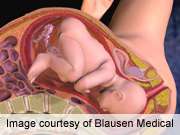The incidence of recurrent anal sphincter rupture is 7.1 percent, and several risk factors are associated with an increased risk, including excessive birth weight, vacuum extraction, and shoulder dystocia, according to research published online Oct. 19 in BJOG: An International Journal of Obstetrics and Gynaecology.
(HealthDay)—The incidence of recurrent anal sphincter rupture (ASR) is 7.1 percent, and several risk factors are associated with an increased risk, including excessive birth weight, vacuum extraction, and shoulder dystocia, according to research published online Oct. 19 in BJOG: An International Journal of Obstetrics and Gynaecology.
Hanna Jangö, from Herlev University Hospital in Copenhagen, Denmark, and colleagues used data from the National Medical Birth Registry in Denmark to identify patients with a first and a second vaginal delivery from 1997 to 2010 and assessed the risk factors for recurrent ASR.
The researchers found that 4.6 percent of the 159,446 women experienced an ASR at first delivery and 7.1 percent had a recurrent ASR (odds ratio [OR], 5.91). The risk of recurrent ASR increased significantly with birth weight (adjusted OR, 2.94 per increasing kg); vacuum extraction (aOR, 2.96); shoulder dystocia (aOR, 1.98); delivery interval (aOR, 1.08 by year); year of second delivery (aOR, 1.06); and prior fourth-degree ASR (aOR, 1.72). Head circumference correlated with significantly reduced likelihood of ASR (aOR, 0.91 per increasing cm).
"The incidence of recurrent ASR in our study population was 7.1 percent," the authors write. "Half of the patients with a recurrent ASR have risk factors, but most factors are first known at the very end of delivery. We need studies to quantify the adverse effects of vaginal delivery after ASR in order to improve counseling and decision-making on the subsequent mode of delivery."
More information:
Abstract
Full Text (subscription or payment may be required)
Journal information: BJOG: An International Journal of Obstetrics and Gynaecology
Copyright © 2012 HealthDay. All rights reserved.






















